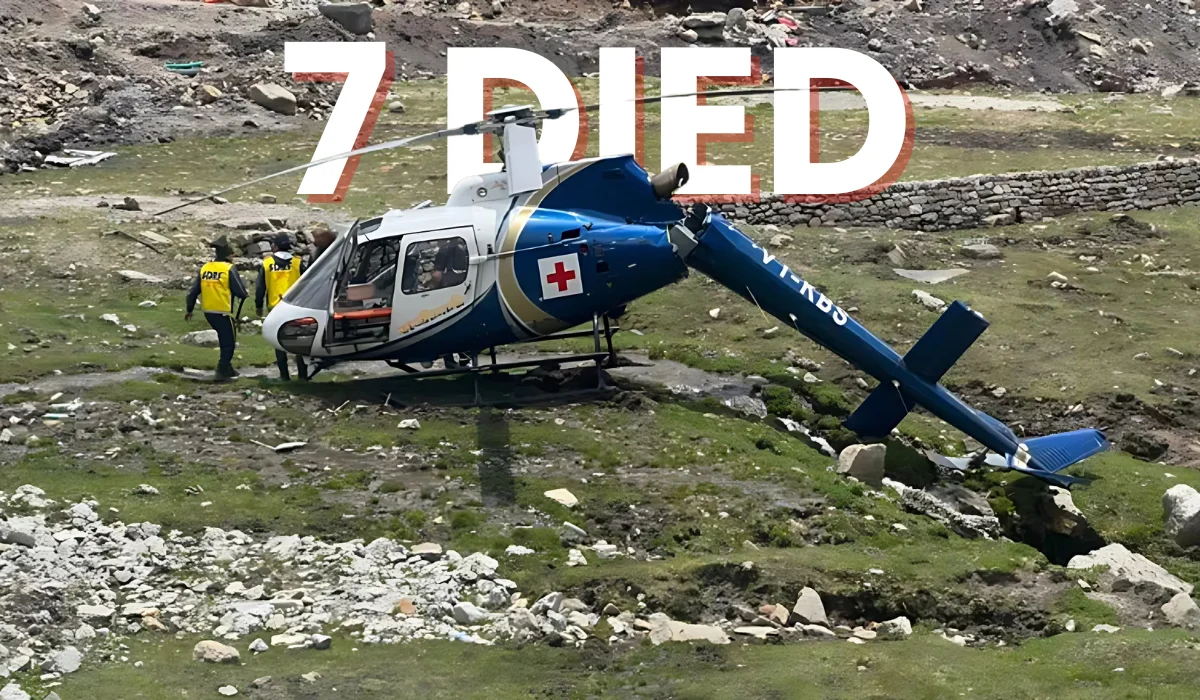It was calm and foggy in the early morning hours when the Bell 407 helicopter departed Kedarnath with a scheduled turnaround toward Guptkashi at about 5:20 a.m. Expecting nothing, only a leisurely a few minutes later, in a flash, it crashed near Gaurikund with low visibility due to dense cloud cover. Flames quickly engulfed the wreckage, and when first responders arrived at the crash site, all passengers – 7 souls (including an infant) – were gone. It’s just sad, right? A simple journey turned into horror. The helicopter was engulfed in the forest, and the corpse was severely burned beyond recognition; witnesses are left with empty disbelief. For now, the Kedarnath area is in mourning as families broke and communities are grieving.
People on twitter started sharing the heartbreaking moment with grief-stricken captions:
These images and memories will stay with people forever—this was supposed to be a peaceful spiritual journey, but it ended in tragedy.
FIR Filed – New Details Nobody’s Talking About
Within a few hours after the crash, law enforcement went into action filing FIRs against Aryan Aviation’s two top executives – Kaushik Pathak and Vikas Tomar. It is not common to file a charge of culpable homicide along with aviation regulations. You can see they are serious. There is lots of tension in the air. Investigators say the helicopter operated outside its allotted time and took off for its return flight into low visibility without confirming weather conditions. Which has you really asking: could this have been prevented?
Additionally, it has been stated that the company violated some SOPs outlined by the DGCA and Uttarakhand Civil Aviation authority. I mean, come on, they disregarded official rules and regulations that are implemented to keep aviation safe when human lives are involve—abysmal negligence! Furthermore, the case forced government authorities to temporarily suspend all Aryan Aviation flights on pilgrimage routes—at the very least, for the next couple of days, until they can figure out what the heck is going on in the hope of preventing another similar situation. It’s good that they are finally asking some of the difficult question—in an attempt to develop some insights—but it still feels like too little too late.
Why This Signals Deeper Safety Issues in the Hills
An ex-operator also advised there are not real radars or weather updates in the area—that really feels like a setup for disaster. This is not only a lack of support—there is no air traffic control, and no current and updated weather. The mountains in this area are exactlyly known for sudden and swirling mists and declining winds below an ordinary flight plan. Pilots should be flying with plans and inputs supported by others. Right now, pilots are flying blind!
Even though the authorities say they’re reviewing procedures, setting up a command center in Dehradun, and suspending flights, it’s not enough until those radars and weather stations are actually working, not just planned.
⚠️ Points Most People Missed
- Single-engine choice: Tourists expect quick chopper rides, but one engine gives no safety margin. Twin-engine machines could survive one failure—why aren’t they mandatory?
- Wild shifts in takeoff timing: Investigators mention flights happened before allowed time slots. That points to scheduling pressure, or worse—profit over safety.
- Fifth crash in six weeks: It shows a pattern, not an accident. This is now a crisis on the pilgrimage circuit—pilgrims deserve safer travel.
- Command center promise: Officials are talking about a centralized command in Dehradun, but no timeline. People deserve up-to-date updates, not vague plans.
- Ground crew readiness: Local responders rushed but lacked night-vision tools. Adding basic infrared cameras could help see through thick forest in rescue situations.
- Infant aboard: One person quietly mentioned a toddler of 23 months. That detail hits hard. Families including young children chose safety and faith—it’s just too hard to process.
Mentioning these makes you think deeper than “it was the weather.” There are structural gaps that need closing—and fast.
What Happens Next: Investigations, Suspensions, and Pilgrims’ Questions
The Aircraft Accident Investigation Bureau (AAIB) is on the case. They’ll analyze black box data, weather logs, flight maps—and figure out exactly how the craft hit terrain while “under control.” Pilgrims and families deserve clarity and closure.
Authorities have already suspended Aryan Aviation’s operations. Licenses for two other firms were even suspended for six months because they flew in similar weather. That’s bold, but it’s not enough unless we see long-term safety improvements.
Meanwhile, the government is under pressure. A state minister from Jharkhand demanded the aviation minister’s resignation, saying it’s unbelievable that one-engine choppers wander into dense fog. Even the Prime Minister, despite being abroad, was briefed. It’s like everyone’s eyes are suddenly on Kedarnath—but sustained attention will matter more than headlines today.
✅ Takeaway Thoughts
At its heart, this is a story about people—pilgrims seeking a blessing, a toddler excited for a journey, families trusting a firm—and how a split-second decision can rip hope from all of them. We’re seeing not just a crash, but warning signs: poor weather monitoring, weak oversight, and a system that values timetables more than safety.
If the FIR leads to accountability, and if radars and twin-engine helicopters become the norm, if rescue crews get better gear—then maybe this tragedy can be a turning point. But pledges need deadlines. Plans need action. Pilgrims need peace of mind.
Let’s hope this isn’t just the latest headline, but the beginning of real change.

